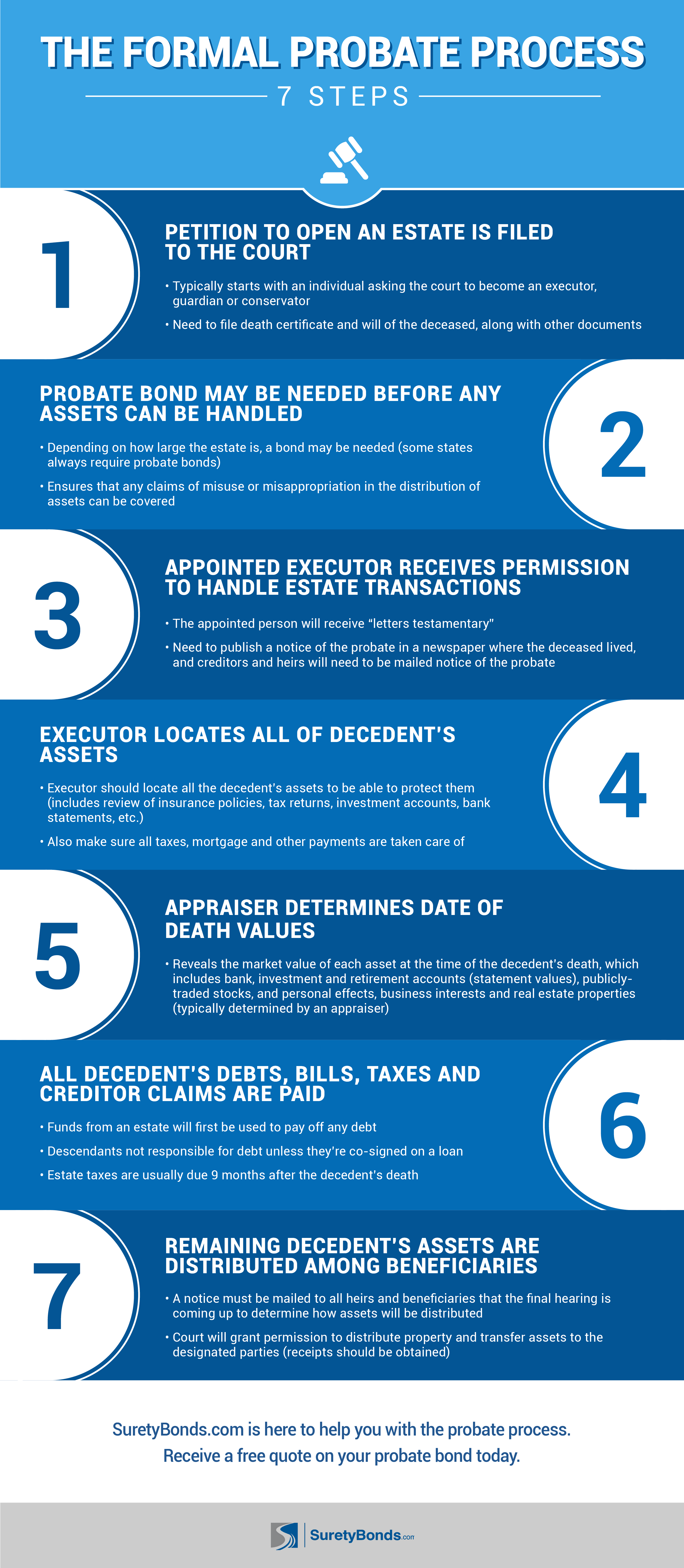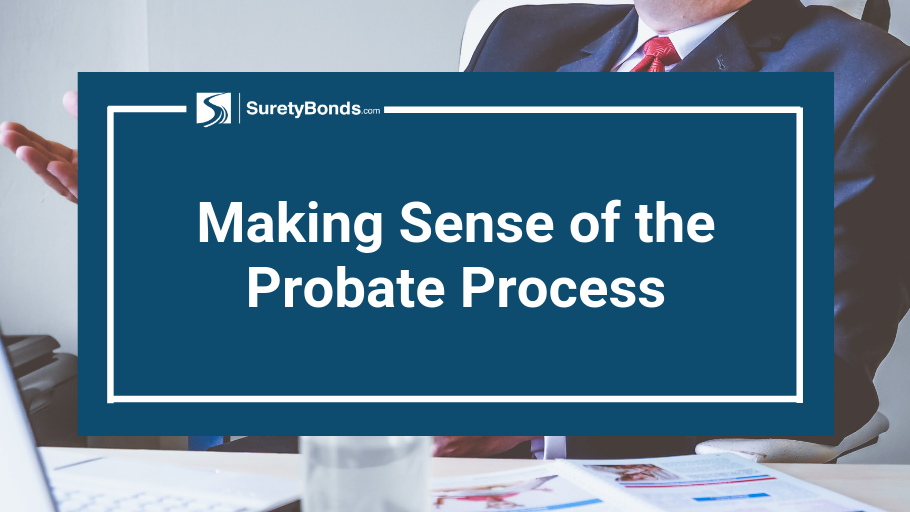For many, figuring out the probate process can be a daunting matter, especially when it so often seems to come during the most difficult of times. In fact, many people may not even be aware of what “probate” even means, and therefore may find themselves asking, “What is probate?” To put it simply, probate generally refers to the proving of a will and it involves court-supervised reorganization and distribution of a deceased or incapacitated person’s assets.
Following the probate process accordingly can prevent things from turning ugly when deciding how to distribute assets. There are many issues to consider with the process, such as whether the formal or informal probate process should be followed, what it means to become the executor, guardian or conservator of an estate, and what to do in the event a will was not drawn up. For more information on the probate process, please feel free to read our additional coverage in The Probate Process: A Q&A With Nathan Jones and The Probate Process: A Guide to Probate Bonds.
Handling Estates: Executors, Guardians, and Conservators
If the need arises, a variety of individuals could be court-appointed to be in charge of handling another individual’s estate. The title of this individual could be executor, guardian or conservator depending on the level of involvement the person in question needs with handling his or her assets.
What is a guardian or conservator?
A guardian or a conservator may be appointed by probate court while an individual is still living in the event the court deems the individual to be incapacitated. An incapacitated person refers to someone who is no longer mentally or physically capable of making important decisions, which could be due to a coma, stroke, or other severe circumstance affecting the individual’s ability to rationalize. The court may appoint a guardian for a fully incapacitated individual, such as someone in a coma, to handle financial and health decisions for the individual. A conservator may be put into place if the individual is socially functioning, but is incapable of mentally handling basic matters, such as math relating to his or her finances. The guardian or conservator is typically a close family member, such as a spouse or adult child, but can be a court-appointed individual if no one else is available.
Who can become an executor?
In the event of someone’s passing, an executor—also referred to as a personal representative—will be appointed by the court to oversee the probate process and settle the deceased’s estate. The individual’s will typically names an individual to serve as the executor. However, if no will is present the court will select an executor—usually a spouse or an adult child. Individuals are under no obligation to accept the position of executor and may refuse for any reason. Often times, individuals who refuse the position do so because they feel the process would be too time-consuming or emotionally stressful. The executor will receive “letters testamentary” from the court, essentially stating the executor has the ability to act and make transactions on behalf of the deceased’s estate. An executor is also bound to serve as a fiduciary, or a person trusted to act in the best interests of another individual, in this case making decisions regarding the distribution of the deceased’s assets.
Administering Assets
The executor, guardian or conservator is responsible for ensuring the deceased’s or incapacitated’s estate is in order by taking inventory of assets and, if needed, having all assets appraised. The IRS will need to be contacted to receive an employer identification number for the estate. If required by state law where the deceased was living at the time of death, the state health or welfare department of the death will also need to be notified by the executor.
The executor will need to arrange for preparation income tax returns, as well as open an estate bank account for the deceased’s assets. Once debts are paid using the deceased’s estate, the executor must file all creditors’ claims that have been approved and denied. If required, file a federal estate tax return and a state estate tax return, typically required within nine months after death. This may be dependent on the size of the estate, as well as which state the deceased was living in at the time of death.
Non–Uniform Probate Code States Process
States that have not adopted the uniform probate code have many different regulations and laws regarding the process and thus should be researched before beginning probate. In the United States, only 16 states have fully adopted the uniform probate code. Without the uniform probate code, a state’s probate process becomes more difficult to streamline and lessens the flexibility for executors.
Uniform Probate Code States Process
Most of the states that have implemented the uniform probate code are similar in probate process laws, but it is ultimately up to every state and county to establish its own specific regulations. There are three kinds of probate under uniform probate code including informal probate, unsupervised formal probate and supervised formal probate.
Informal Probate
Informal probate happens when the probate process is going relatively well, with no contention between inheritors or problems with creditors. This process doesn’t require any official court hearings except for relevant paperwork needing to be filed. Informal probate is typically easier and less expensive than formal probate.
Unsupervised Formal Probate
This process is used when it is deemed necessary a court becomes involved with the probate process. For instance, court involvement may be necessary if the distribution of the estate’s assets is in question, the deceased has no valid will and heirs need to be determined, or if minors are inheriting significant assets.
Supervised Formal Probate
This process may be used if an heir is deemed not capable of looking after his or her own interests and thus needs a court involved for protection of the estate. Because it is only used when the court deems supervision to be necessary, this process is not implemented very often.
The Formal Probate Process in 7 Steps
1. Petition to open an estate is filed to the court
The probate process typically starts with an individual asking the court to become an executor, guardian or conservator, usually after being named in the deceased’s or incapacitated’s will.
Along with the petition, the individual will need to file a request for probate in the county in which the deceased or incapacitated person was living in when he or she died. The deceased’s death certificate and the individual’s original will, if there is one, will also need to be filed with the court. For the court to prove the will is valid, a “self-proving affidavit” can be provided, which refers to the act of the witness signing the will in the presence of a notary. There may also be other documents required by the court, which should be filed during the probate process.
2. Probate bond may be needed before any assets can be handled
Depending on how large the estate is of the deceased individual, otherwise known as the decedent, the executor may be required by the court to obtain a surety bond to ensure that any claims of misuse or misappropriation in the distribution of assets can be covered. Some states always require this type of bond, especially if the the executor isn’t someone nominated in the will or if he or she lives out of state. Essentially, a probate bond protects the estate from intentional or unintentional losses accrued by the executor.
The premium, or cost of a bond, is a percentage of the total bond amount, which is usually about 0.5% of the total estate value that the fiduciary will be responsible for. In other words, the actual amount of the bond is dependent on the size of the estate and how much the assets of the deceased or incapacitated individual are worth. Note that estate funds can be used to cover the cost of a bond.
Probate bonds can be purchased through an insurance provider to cover any potential losses due to the mishandling of assets by an executor, guardian or conservator.
3. Appointed executor receives permission to handle estate transactions
When the court grants the executor, guardian or conservator permission, the appointed person will receive “letters testamentary”, which document permission given to handle estate assets. Additionally, a notice of the probate will also need to be published in a newspaper local to where the deceased lived at the time of death. All creditors and heirs will need to be mailed notice of the probate, as well as proof, which needs to be provided to the court that the notice was published and mailed to all relevant parties.
4. Executor locates all of decedent’s assets
As soon as the executor has permission from the court and a probate bond (if necessary), he or she should locate all the decedent’s assets to be able to protect them throughout the probate process. This can be done through a review of insurance policies, tax returns, etc. To protect real estate, or the decedent’s home, the executor should make sure all taxes, mortgage and other payments are taken care of. Locating all of the assets includes collecting bank statements and any investment accounts.
5. Appraiser determines date of death values
The “date of the death” estate value simply reveals the market value of each asset at the time of the decedent’s death. This includes:
-
Bank, investment and retirement accounts (statement values)
-
Publicly-traded stocks
-
Personal effects, business interests and real estate properties (typically determined by an appraiser)
6. All decedent’s debts, bills, taxes and creditor claims are paid
If the deceased has accumulated any debt in any manner, funds from his or her estate will first be used to pay off the money owed. Descendants are not responsible for their loved one’s debt unless they are co-signed on a loan or other type of agreement that makes them an equally liable party for the money owed. Typically assets are distributed first for the expenses associated with asset administration, then any funeral expenses, followed by debts and taxes accumulated by the individual and then finally distributed to all other claims on the estate. Any claims made by creditors must be paid. Along with paying the creditors, the executor must make sure any other bills and taxes are taken care of. Estate taxes are usually due 9 months after the decedent’s death.
7. Remaining decedent’s assets are distributed among beneficiaries
An estate may be closed after all debts have been paid, all necessary tax returns have been filed and the creditor’s claim period has passed. As part of the last step in the probate process, the estate may be distributed to beneficiaries. A notice must be mailed to all heirs and beneficiaries that the final hearing is coming up to determine how assets will be distributed and proof must be filed that the notices were mailed. The court will then grant permission to distribute property and transfer assets to the designated parties. Once all assets have been distributed, receipts should be obtained and the executor will ask the court to be relieved of their duties.
The probate process can be tricky to navigate, especially in dealing with such a sensitive situation such as the death or incapacitation of a loved one. However, by reading this guide, you have hopefully gained at least some understanding of the process, which will allow it to be handled more easily in the event you find yourself in the role of executor of an estate or need to serve as a guardian or conservator.
How do I get a surety bond for my court or probate case?
You can apply for a court or probate bond online 24/7 or call 1(800)308-4358 to speak with a surety expert about your bonding needs.
See the graphic below for an outline of the formal probate process.

